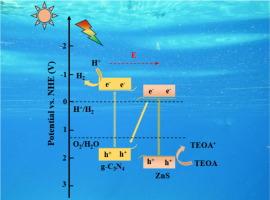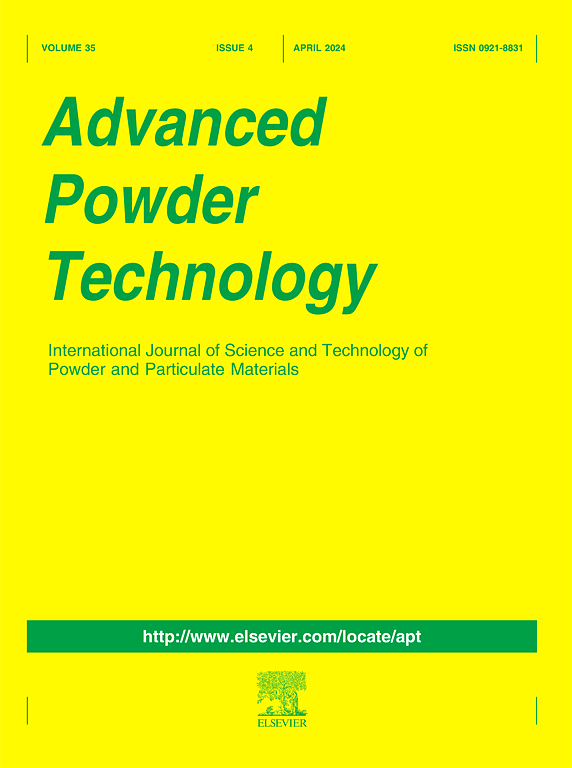一步固相合成高效异结光催化剂ZnS/g-C3N4制氢
IF 4.2
2区 工程技术
Q2 ENGINEERING, CHEMICAL
引用次数: 0
摘要
可见光利用率较低,光生载体复合速度快,严重制约了g-C3N4的光催化性能。在本研究中,我们以Zn (CH3COO) 2·2H2O和硫脲为前驱体,通过简单的一步固相法成功构建了稳定的ZnS/g-C3N4异质结光催化剂。紫外-可见DRS测试结果表明,ZnS/g-C3N4能显著提高吸收能力,拓宽光的吸收范围,光电化学和光致发光光谱分析表明,ZnS/g-C3N4能有效削弱载流子复合。H2演化实验表明,在可见光照射下,100 ZnS/g-C3N4 (100- zscn)催化剂的H2生成速率比裸g-C3N4或具有相同助催化剂Pt的ZnS高22倍以上。基于实验表征、密度功能理论计算和光催化活性测试,我们对其光催化制氢机理进行了理顺。该研究对开发高效产氢光催化剂具有重要意义。本文章由计算机程序翻译,如有差异,请以英文原文为准。

One-step solid-phase synthesis of an efficient heterojunction photocatalyst ZnS/g-C3N4 for H2 production
The relatively low utilization ratio of visible light and fast recombination of photogenerated carriers seriously restrict the photocatalytic capability of g-C3N4. In this study, we used Zn (CH3COO) 2·2H2O and thiourea as precursors to successfully construct a stable ZnS/g-C3N4 heterojunction photocatalyst through a simple one-step solid-phase method. The results of the UV–vis DRS test show that ZnS/g-C3N4 can significantly improve absorption capacity and broaden the absorption range of light, and photoelectrochemical and photoluminescence spectroscopy show that it effectively weakens carrier recombination. The H2 evolution experiments show that under visible light irradiation, the H2 generation rate of the 100 ZnS/g-C3N4 (100-ZSCN) catalyst is more than 22 times higher than that of bare g-C3N4 or ZnS with the same co-catalyst Pt. Based on experimental characterization, density functional theory calculations, and photocatalytic activity tests, we rationalize its photocatalytic hydrogen production mechanism. This study has significant implications for exploiting efficient photocatalysts for H2 production.
求助全文
通过发布文献求助,成功后即可免费获取论文全文。
去求助
来源期刊

Advanced Powder Technology
工程技术-工程:化工
CiteScore
9.50
自引率
7.70%
发文量
424
审稿时长
55 days
期刊介绍:
The aim of Advanced Powder Technology is to meet the demand for an international journal that integrates all aspects of science and technology research on powder and particulate materials. The journal fulfills this purpose by publishing original research papers, rapid communications, reviews, and translated articles by prominent researchers worldwide.
The editorial work of Advanced Powder Technology, which was founded as the International Journal of the Society of Powder Technology, Japan, is now shared by distinguished board members, who operate in a unique framework designed to respond to the increasing global demand for articles on not only powder and particles, but also on various materials produced from them.
Advanced Powder Technology covers various areas, but a discussion of powder and particles is required in articles. Topics include: Production of powder and particulate materials in gases and liquids(nanoparticles, fine ceramics, pharmaceuticals, novel functional materials, etc.); Aerosol and colloidal processing; Powder and particle characterization; Dynamics and phenomena; Calculation and simulation (CFD, DEM, Monte Carlo method, population balance, etc.); Measurement and control of powder processes; Particle modification; Comminution; Powder handling and operations (storage, transport, granulation, separation, fluidization, etc.)
 求助内容:
求助内容: 应助结果提醒方式:
应助结果提醒方式:


